Avez-vous déjà eu des problèmes avec votre site WordPress, mais vous ne pouviez pas accéder à la zone d’administration pour dépanner ? C’est une expérience frustrante à laquelle de nombreux utilisateurs/utilisatrices de WordPress sont confrontés à un moment ou à un autre.
Une étape par étape du dépannage consiste à désactiver toutes les extensions, puis à les réactiver une par une. Cela aide à identifier si un conflit d’extensions en conflit est à l’origine du problème. Mais que faire lorsque vous ne pouvez même pas vous connecter à wp-admin pour effectuer cette étape importante ?
Ne vous inquiétez pas, il y a une solution. Dans ce guide, nous allons vous afficher comment désactiver toutes les extensions WordPress lorsque vous êtes bloqué hors de votre zone d’administration.
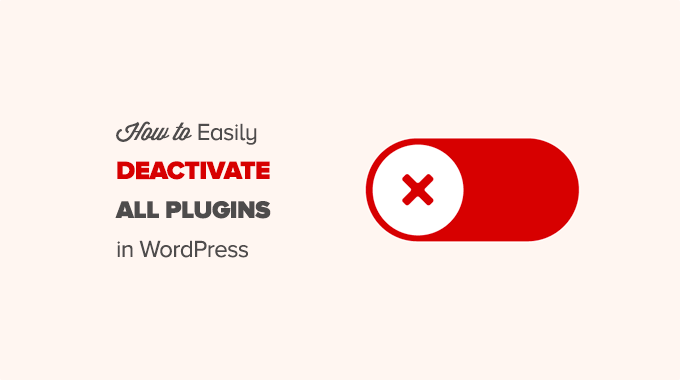
Il existe deux méthodes couramment utilisées pour désactiver des extensions sans accéder à la zone d’administration de votre site WordPress. Vous pouvez choisir la méthode qui vous semble la plus facile :
Méthode 1 : Désactiver toutes les extensions WordPress par FTP
Pour cette méthode, vous devrez utiliser soit un client FTP, soit l’application de gestion de fichiers dans le panneau de contrôle de votre hébergeur WordPress.
Si vous n’avez jamais utilisé le protocole FTP, vous pouvez consulter notre guide sur l’utilisation du protocole FTP pour téléverser des fichiers sur WordPress.
Tout d’abord, vous devez vous connecter à votre site à l’aide d’un client FTP ou du gestionnaire de fichiers de cPanel. Une fois connecté, vous devez naviguer jusqu’au dossier /wp-content/.
Dans le dossier wp-content, vous trouverez un dossier appelé plugins. C’est là que WordPress stocke toutes les extensions installées sur votre site.
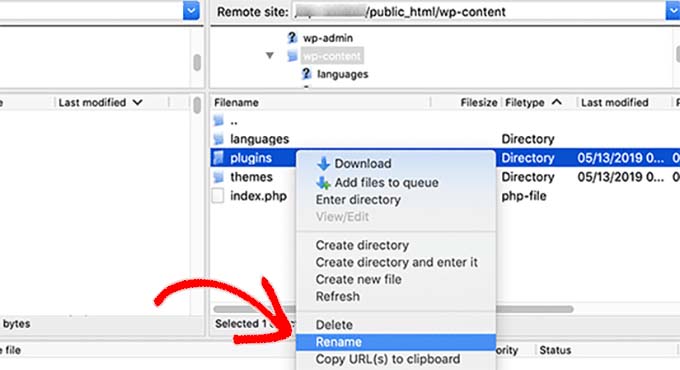
Vous devez cliquer avec le bouton droit de la souris sur le dossier des extensions et sélectionner “Renommer”.
Ensuite, changez le nom du dossier en ce que vous voulez. Dans notre exemple, nous l’appellerons plugins.deactivated.
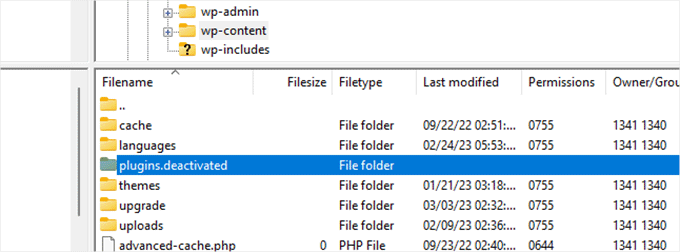
Une fois cette opération effectuée, toutes vos extensions seront désactivées.
En effet, WordPress recherche un dossier appelé “plugins” pour charger les fichiers d’extension. Lorsqu’il ne trouve pas ce dossier, il désactive automatiquement les extensions activées dans la base de données.
En général, cette méthode est utilisée lorsque vous êtes bloqué dans votre zone d’administration. Si le problème est lié à vos extensions, vous devriez pouvoir vous connecter à la zone d’administration de WordPress.
Si vous visitez la page Plugins ” Installed Plugins à l’intérieur de la zone d’administration de WordPress, vous verrez des notifications pour toutes les extensions qui ont été désactivées.
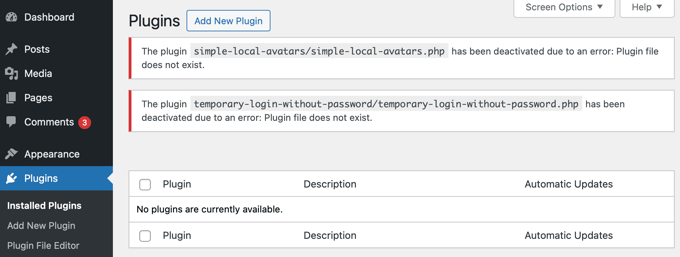
Vous remarquerez également que toutes vos extensions ont disparu. Ne vous inquiétez pas, ils sont tous en sécurité et vous pouvez facilement les restaurer.
Revenez simplement à votre client FTP et allez dans le dossier /wp-content/. À partir de là, vous devez renommer le dossier plugins.deactivated en plugins.
Vous pouvez maintenant retourner à la page “Plugins” “Installed Plugins” dans la zone d’administration de WordPress et activer une extension à la fois jusqu’à ce que votre site s’arrête à nouveau.
À ce stade, vous saurez exactement quelle extension est à l’origine du problème. Vous pouvez alors supprimer le dossier de cette extension de votre site à l’aide du FTP ou demander le support de l’auteur/autrice de l’extension.
Méthode 2 : Désactiver toutes les extensions à l’aide de phpMyAdmin
La méthode FTP est certainement plus facile, à notre avis. Cependant, vous pouvez également désactiver toutes les extensions WordPress à l’aide de phpMyAdmin.
Important : Avant toute chose, veuillez effectuer une sauvegarde complète de la base de données. Cela vous sera utile en cas de problème.
Ensuite, vous devez vous connecter au tableau de bord de votre hébergeur. Dans cet exemple, nous vous affichons un tableau de bord cPanel. Le tableau de bord de votre hébergeur peut être différent.
Vous devez cliquer sur l’icône “phpMyAdmin” sous la section Bases de données.
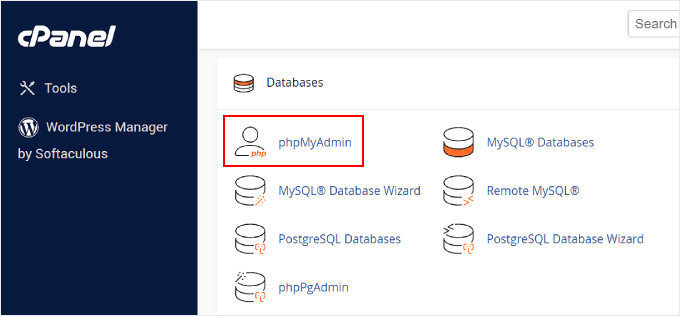
Ceci lancera phpMyAdmin dans une nouvelle fenêtre du navigateur.
Vous devrez sélectionner votre base de données WordPress si elle ne l’est pas déjà. Après cela, vous pourrez voir les tables de la base de données WordPress.
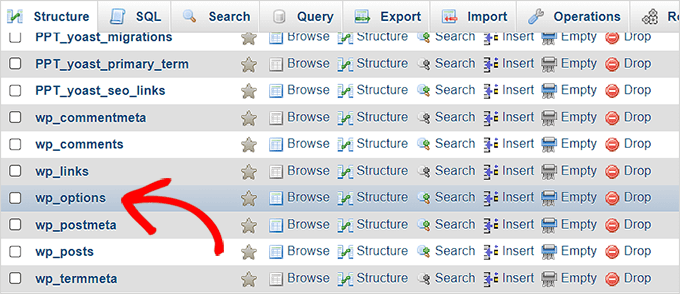
Comme vous pouvez le voir, toutes les tables de la base de données ont le préfixe wp_ avant le nom de la table. Vos tables peuvent avoir un préfixe de base de données différent.
Vous devez cliquer sur le tableau wp_options. À l’intérieur du tableau wp_options, vous verrez des lignes de différentes options. Trouvez l’option ‘active_plugins’ et cliquez sur le lien ‘Modifier’ à côté.
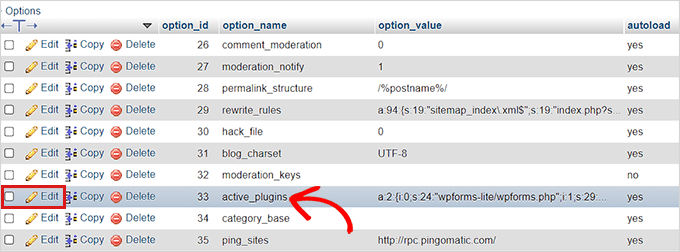
Dans l’écran suivant, vous devrez modifier le champ option_value en a:0:{}.
Cliquez ensuite sur le bouton “Go” pour enregistrer vos modifications.
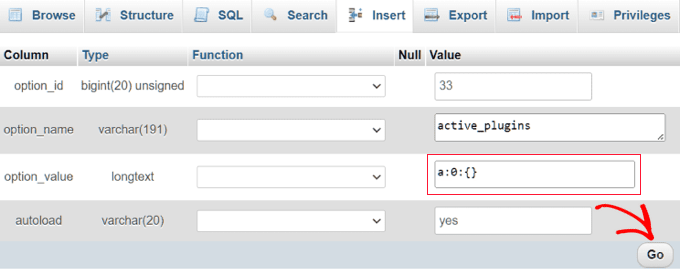
Vous avez bien désactivé toutes les extensions WordPress en utilisant phpMyAdmin. Si une extension vous empêchait d’accéder à l’administration de WordPress, vous devriez pouvoir vous connecter maintenant.
Tutoriel vidéo
Guides d’experts sur les extensions WordPress
Nous espérons que cet article vous a aidé à désactiver toutes les extensions de WordPress. Vous pouvez également consulter d’autres guides sur le dépannage des extensions WordPress :
- Que sont les extensions WordPress ? Et comment fonctionnent-ils ?
- Comment désactiver facilement les extensions WordPress (Guide du débutant)
- Comment activer les extensions WordPress à partir de la base de données ?
- Les extensions inactives ralentissent-elles WordPress ? Faut-il les supprimer ?
- Combien d’extensions WordPress devriez-vous installer ? Qu’est-ce qui est trop ?
- Est-il sûr d’utiliser des extensions WordPress obsolètes ? (Expliqué)
- Faut-il installer des extensions qui n’ont pas été testées avec votre version de WordPress ?
- Comment mettre à jour correctement les extensions WordPress (étape par étape)
- Dois-je mettre à jour WordPress ou les extensions en premier ? (Trier par ordre de mise à jour)
Si vous avez aimé cet article, veuillez alors vous abonner à notre chaîne YouTube pour obtenir des tutoriels vidéo sur WordPress. Vous pouvez également nous trouver sur Twitter et Facebook.





Josh
This worked great for me to solve the 500 error. Thanks!
Andy
Renaming the Plugins directory via cPanel file manager did the trick! Thanks so much!
Gordon
Thank you so so much!
BTW I used cPanel File Manager
Kieron
This was a big help. Renaming the plugin directory did the trick for me and once I located the problematic plugin all is well. Thanks for the info.
sharmila
as a beginner wordpress user, your post done great help. Thank you
Olivier Deschères
Thank you so much, your article saved my site ! I faced error 500 during a plugin-upgrade. Just like you told : renamed \plugins, then could connect as wp-admin. I saw my site in an uggly way but worked technically. All plugins seemed’uninstalled’. I renamed my folder to \plugins again. Refreshed my wp-admin page and i could activate one-by-one. You are fantastic, thx for the article!
WPBeginner Support
Hey Olivier,
We are glad you found it helpful. Don’t forget to join us on Twitter for more WordPress tips and tutorials.
Admin
Will
Thanks so much for the advice about disabling plugins via FTP. Worked perfectly when I felt a little panicked after an upgrade!
Michelle
Thank you SO MUCH, this worked perfectly. As soon as I disabled the plugins using your method I was able to login – phew – and reactive each plugin as I needed them. Hadn’t accessed the site backend in a while so it was time to do a cleanup. Again, you saved me so much time. Thank you xx
Graham Peckham
Good article but sadly did not solve my problem which is this.
I could not change from Text to Visual, it was only on visual, could not insert Media and could not edit the Permalink!
If I rename plugins folder my editor works fine, but it I rename all the plugins individually I still have the problem and so could not find which is causing the problem, maybe two are causing it…. Any advice?
Help…….
Teo Dumitru
Thank you so much! Apparently it was all about a plugin.
Ankit
Thanks a lot this really helped.
Mel Mills
Worked great. Thank you!
Juni Tjoa
Thank you so much for the guide.
It is real useful.
Experienced white screen of death, and fixed it in mins thanks to your super easy to follow instruction!
Sarah
Thank you for the guide.
Also to deactivate a specific plugin, just rename the specific plugin folder in the c-panel
Ali
Thanks for the advice, that got my site back up and gave me access to my admin area. However I’m struggling to reactivate the plugins. I’m seeing no plugins installed and when I try to re-install I get “cannot create directory”
any ideas?
Thanks again,
Ali
WPBeginner Support
Hi Ali,
Please connect to your website using an FTP client or File Manager in cPanel. Go to /wp-content/ folder and make sure it has a plugins folder inside it. If it doesn’t, then you need to create one. After that try installing plugins again.
If you do have plugins folder, then check its file and directory permissions.
Admin
Nadim
Hello, Most of the time, we have the plugin conflict issues, in that case, we deactivate all plugins and enable one by one to check which plugin is the main culprit. I wish there was a plugin which will ease this process, disabling all plugins and and option to enable one by one.
mourad
thanks for the tutorial
you’re a life saviors
Issahaku Adam
Thanks a lot.
This is a masterpiece. I have been able to recover my sight after deactivating all my plugins. I got scared when I recovered the site because it was a complete mess. But upon activating all the plugins everything came back to normal. That’s why I will always be a fan of your blog. Thanks
Issahaku Adam
Hi,
I have been a fun since I started my WordPress site this January. I followed your blog today on how to install site maintenance plugin. I was able to install, activate and use it. But unfortunately my laptop shut down unexpectedly afterward and I have realized that I have been logged out of my site. I did everything possible but it is simply not working. I would be grateful if you could help. Thanks.
WPBeginner Support
Hello,
Please see the article above to deactivate all WordPress plugins. This will allow you to login and then you will be able to activate plugins one by one.
Admin
Jeff Rudd
Tried this solution but still have the whiteout page. As such cannot even gain access to the site dashboard, to further change or remove anything further.
The solution above needs to be updated with further suggestions what to do, when the above tip doesn’t work. As it is, now I have a site that the public can view – but one that I cannot gain access to for dashboard repairing or anything else.
WPBeginner Support
Hi Jeff,
For more tips see our WordPress troubleshooting guide and our article on most common WordPress errors.
Admin
allie
I tried both versions but still get a HTTP Error 500 and am unable to access the backend of my wordpress site.
Tecezzi
Thank you so much this tip.
Araceli Tzigane
Your tip about renaming the plugins folder has been what saved my nervous system. Wow, thousand of thanks!!!!
NIc Kra
Tried activating woocommerce plugin and it broke the site. At first I had the Maintenance screen and now I have a 500 error. I can’t access anything through wp-admin or FTP. Using phpmyAdmin, I cannot locate any tables/columns etc named wp_options following your example.
Muhammad Rashid Mukhtar
Great Article. I just troubleshoot a problem which was never in google search using your steps. My all pages were showing a password field and submit button. After deactivating all plugins using your method and reactivating one by one showed that jetpack is corrupted and overriding all other hooks. Great help for me.
Melwyn
Your information was a real life-saver. Thanks for the post and for saving my site.
Shafiq Anjum
Thank you so much for this tip
Shafiq Anjum
Thank you guys for the help.solve issue via phpmyadmin.
Ira
Hi there,
I’m trying to rename the plugins folder via FTP because I can’t login the admin. But I keep getting “access is denied” when I try to rename an active plugin.
Can you help me out?
Thanks!
Steve
Thanks. The FTP approach to plugins folder worked perfectly for me!
Ankit
Thank you for your article, i changed the plugin folder name and was able to login to admin panel again.
Toby Rzepka
Hmm, when I rename the folder back to “plugins,” I’m whitescreened out of admin again. How are people able to reactivate their plugins one by one?
Sophy
Thankyou!
Saved me from a mini freak out episode. I appreciate your article. Every step worked for me!
Berit
I deactivated the plug-ins, now nothing works anymore. When I try to go on my page it says there is no connection to the database. What can I do?
WPBeginner Support
You can now try activating plugins one by one.
Admin
Fiona
This just happened to me too, help! ‘Error establishing a database connection’.
I cut and pasted the text back, but still getting the error message.
baraa ihab
ok such an informative article really appreciate it. here is the problem i have reached the white page of doom and i dont ave access to the cpanel is there a turn around to fox this i already know the plugin causing the problem
vinod
Fatal error: Maximum execution time of 30 seconds exceeded in /home/webtech1/public_html/wp-includes/post.php on line 4375
Paul
FTP Worked … Thank you! The culprit was Discussion Board plugin when I went private setting to work on it the next day on those pages and logged out for the night… lol thanks again!
Maria
Deactivating all plugins using FTP works for me. The issue was the Visitors-Traffic-Real-Time-Statistics plugin. Thanks a lot.
Maggie
Hello,
It doesn’t seem like it was the plugins that caused the issue. I remember I was tweaking some codes in functions.php about the header, and all of sudden I was logged out. Would be greatly appreciated if you can help out!
Maggie
yatheesh.k.
Plugin not tested with wordpress or not compatible with wordpress create white death to site.
Thanks for your post, really helped me to retrieve my web site .
Indrek
Can use only
https://example.com/wp-login.phpnothttps://example.com/wp-admin/and when I push to entry button it shows me HTTP ERROR 500Norm
Thank you so much for this useful tip. It saved me a lot of time when I couldn’t log into my site after repeatedly requesting new passwords. I found which plugin was causing the problem.
Jimena Flores
I know nothing about coding and decided to create my own portfolio site using wordpress. This post saved my life as I had an error after a plugin I installed. Thank you!
Eugene
I am not a developer or IT expert – don’t know much about this field and recently learned online how to create website and host it myself. However when something breaks I am reliant on forums like these to save me which this post did. I had an issue with Miniorange 2-factor authentication plugin which did not allow me to login, and then after numerous attempts to login got the Too many requests message.
I solved the Too many requests issue by temporarily disabling ModSecurity in cPanel and then solved the miniorange issue by renaming the folder as noted in your forum. Everything works again and all is well with the world. Thank you.
Raj singh
I can’t Find wp_option option in php my admin.
So now what should I Do ??
Please help me.
Ramona
Hello,
This article was very helpful. I had a problem with a plugin that I have installed. Changed it’s name in the FTP file and the website and admin worked again
Thank you
Paul LeBlanc
So helpful, i copied these pages to Evernote!
I had a bad plugin and not enough memory allocated.
Thanks tons!
Gavin
Hey, This was very helpful in a very stressful situation so thank you!
Bayo
I tried to backup my site, the backup didn’t complete. Since then I been unable to access wp-admin page.. Always white. What else can I do? Thanks
WPBeginner Support
Hey Bayo,
You can follow the steps in our WordPress troubleshooting guide to figure out the issue and find a fix.
Admin
Hal
The tip about turning off the plugins via the batabase is solid gold.
Bogdan
Thank you for this useful tutorial! You saved my night!